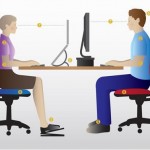Ergonomics are a big part of keeping yourself safe and functioning efficiently while you’re at work. There are of course a lot of steps you can take to make sure that you are in fact working ergonomically. Below we will go over 8 different things you can do while you’re at work to improve your performance using ergonomics, some things may include using an ergonomical chair or improving your posture.
- Ergonomical Chair Will Help You Maintaining Good Posture
Good posture is crucial for your bones and muscles, and you want to try keeping a neutral posture, especially if you work in the office since you spend more time sitting. This basically means you want to keep pressure off your joints by keeping them aligned. This means that your muscles, tendons, nerves and bones are relaxed and ready to work. Awkward postures or positions put stress on your body and can contribute to MSD.
A great way to maintain proper posture (and minimise the pressure on your hips, reduce neck and back problems and pain) is by using an ergonomical chair. Unlike traditional models, an ergonomical chair features a head and back rest which support your posture. You can also adjust the height to ensure your knees are parallel to your hips and feet are flat on the floor. Aside from featuring a design that will help align your body the right way, ergonomic chairs are also user-friendly, hence comfortable. - Lighting
Aside from investing in ergonomic essentials (ergonomical chair, desk, keyboard, mouse, etc.) to revitalise your workplace, it is also crucial to have sufficient lighting as it can easily effect your comfort and performance. A work area without enough lighting can cause your eyes to get tired as well as headaches. Dimly lit rooms also make it easier to sustain injuries. Anyone who works at a computer all day should also take steps to control the glare of the screen to make sure that your eyes are comfortable. - Lift Carefully
If your job requires you to lift and carry items make sure you are carrying items within your power zone. This is exactly between your mid-thigh and mid-chest area, it is the area of your body where your arms and back use the least amount of effort. If you’re not sure where this is on your body, pretend to extend your hand to shake someone else’s, this is probably your power zone. - Stretch More Often
Our bodies are not made to do one thing for a long period of time; the body needs to move and stretch. Even if you are sitting all day in one position, this can actually cause you to feel fatigued. Make sure that you do stretches at least every 30 minutes, get up go for a walk, stretch out your shoulders and finger; get up do a few squats. All of these things are great to get your blood moving again and to give you a boost of energy. - Avoid Strenuous Work
If you work in an environment where you are required to go tough physical work then you must try to calm your efforts down in a way to make sure you last throughout the day. There is no point in trying your hardest in the morning only to burn out by lunch time. Take your time and go at a reasonable pace. If any of this strenuous work can be avoided then you should do so. - Avoid Repetitive Motions
If you have a job that requires you to do something over and over again then this could also be an ergonomic risk. This is especially dangerous for those who are sitting or standing in awkward positions. This is a factor that can contribute to MSD also, you should note that repetitive motions are considered to be repetitive cycles for more than 30 seconds. If possible take breaks and try to avoid this. - Contact Stress
This is something that you may not be aware of. Contact stress can mean anything from rubbing or continuous contact between you and something else. This could be the edge of a desk or tools in your hands. It can create localized pressure in areas of the body which can inhibit blood, nerve function, and movement of muscles. - Vibrations
Vibrations can be bad if they are excessive. Excessive vibrations can lead to adverse health issues which you can see with people who tend to work with heavy machinery. There are many health issues linked with this which include tendinitis, carpel tunnel syndrome, Raynaud’s syndrome, and hand-arm vibration syndrome.


